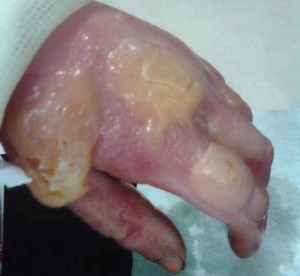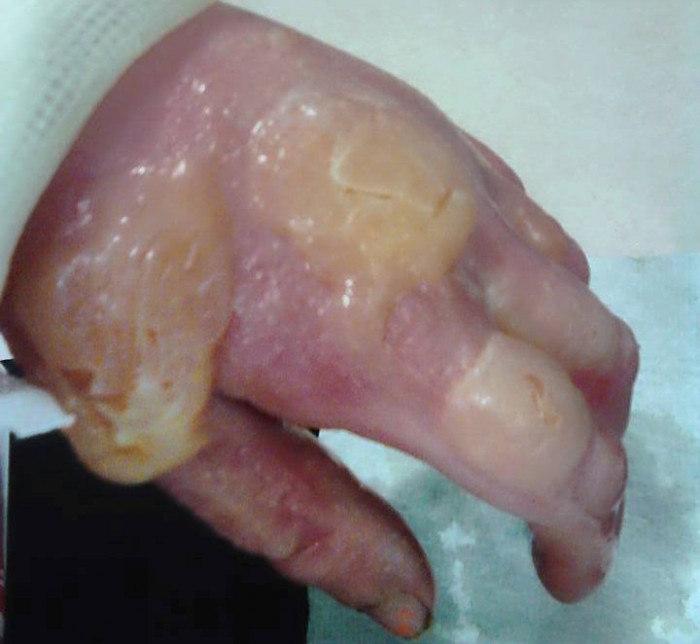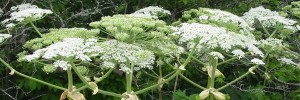Lauren Fuller is 10-years old. She was building a den by a Scottish riverbank when she picked up the invasive plant, Giant Hogweed (Heracleum mantegazzianum), which grows wild across the countryside.
Within 24 hours she had bright red burns on her hands and cheeks – but when her parents took her to hospital, they were told it was just sunburn.
As you can see from the photo below, this was no sunburn.
Sadly, the effects and dangers of Giant hogweed are not limited to Scottish riverbanks. Nowadays, the toxic plant grows in Connecticut, New York, Pennsylvania, Ohio, Maine, Maryland, Oregon, Washington, Massachusetts, Michigan, Virginia, Vermont, North Carolina, New Hampshire, Indiana and Maine.
In fact, thirty giant hogweed plants were found in 2018 in Virginia’s Clarke County, northwest of Washington D.C., according to The Massey Herbarium at Virginia Tech.
Isle of Wight County Virginia posted on Facebook that additional plants had been reported in the area of Staunton near Charlottesville, and Middlesex County, east of Richmond.
Giant hogweed is native to the Caucasus Region and Central Asia. It was introduced to Britain as an ornamental plant in the 19th century, but has now spread to many other parts of Europe, the United States and Canada.
It looks like a giant version of cow parsley (Queen Anne’s Lace), which we are not instinctively scared of, even though it smells a bit rank. Giant hogweed can reach over 10ft in height.
It’s not only invasive – it grows like a rampant weed – but it’s tenacious. While other biennials die off after two years, giant hogweed can keep coming back year after year, out-growing and displacing all the friendlier (more desirable) plants around it.
Danger to humans
The sap of giant hogweed causes phytophotodermatitis in humans, resulting in blisters, long-lasting scars, and—if it comes in contact with eyes—blindness. These serious reactions are due to the furocoumarin derivatives in the leaves, roots, stems, flowers, and seeds of the plant.
Giant hogweed sap contains toxic chemicals known as photosensitizing furanocoumarins. When these chemicals come into contact with the human skin, it can cause a skin reaction that’s extremely sensitive to light.

The light-sensitive skin reaction causes dark painful blisters that form within 48 hours, and result in scars that can last anywhere from a few months to six years. Touching giant hogweed can also cause long-term sunlight sensitivity, and blindness if sap gets into a person’s eye. Blistering can re-occur for many years.
The N.Y. Department of Health recommends that you wash it off with cold water immediately and get out of the sun. A toxic reaction can begin as soon as 15 minutes after contact. Apply sunscreen to the affected areas since this can prevent further reactions if you’re stuck outside. Compresses soaked in an aluminum acetate mixture – available at pharmacies – can provide relief for skin irritations.
Don’t expose the area you believe to have been affected to sunlight for at least 48 hours. Wash your eyes with water and wear sunglasses. They advise to seek a medical’s opinion to confirm there has been no infection.
If hogweed sap gets into the eye, rinse them with water immediately and put on sunglasses. Get to an eye doctor for irrigation and a check-up asap!
Don’t mow or weed-whack the plant, apparently they like it and it will just send up new growth and potentially expose you to toxic sap. Call a professional or local authorities who can properly destroy the plant and its seeds. Here is the USDA website link for reporting pests.
And of course, call a doctor if you’re experiencing a severe reaction.
How To Control Giant Hogweed
The information on this page is available in a more extensive PDF format. View complete Giant hogweed Control Methods (PDF, 500 KB) document.
Giant hogweed can be controlled manually, mechanically, and with herbicides. In some cases, a giant hogweed infestation is best controlled using several different methods in combination or in succession – in other words, a two, three, or even four-pronged attack plan. The final part to any control method is to plant grasses or other vegetation to provide competition for giant hogweed and decrease soil erosion.
In order for your control effort to be successful, you will have to ensure that no additional seeds are being introduced to the area. With no influx of seed and a few years of persistent control efforts, giant hogweed plants can be eradicated.
Before beginning or performing giant hogweed control, be sure to carefully read and follow the Health Hazards & Safety Instructions (this page contains graphic photos)!
Overall Giant Hogweed Control
- Prevent introduction into new areas
- Do not move soil contaminated with seed. If removal of contaminated soil is necessary, seedling emergence can be prevented by burying the soil to a minimum depth of 20 inches (50 cm) and covering it with clean soil
- Sowing and planting giant hogweed is PROHIBITED
- Since the dispersal of giant hogweed is almost entirely by seeds, it is very important to prevent the plant from setting seed
- Control new, smaller infestations first before the seed bank has a chance to establish

Field technician root-cutting hogweed plants.
Manual & Mechanical Control
Methods include root cutting, flower head/seed head removal, cutting and mowing, and cut and cover. Except for root cutting, manual control will not cause immediate death of the plant. All other methods will need two to three treatments per year for several years to deplete the root reserves and kill the plants. All methods will need to occur for multiple years until no new plants grow from the seed bank. Monitor the site for at least three more years to make sure no new seedlings appear.
a. Root cutting
- This method is ideal for a single plant or small infestations. We have found 400 plants to be a manageable amount for two people to control manually.
- Cut the taproot approximately six inches below ground level using a spade, shovel, or anything with a large sharp edge. In areas with erosion or on steep inclines (where additional soil may be covering the plant base), plants may need to be cut up to ten inches below the soil.

When cutting the root you need to separate the thick stem base bearing old leaf scars from the root below.
- If possible (for your safety), cut the plants before the leaves are very large.
- The cut part of the plants should be removed from the soil and left out to dry (safest for control person) or bagged and disposed of.
- If the plants do not die, cut them again when they regrow.
- When using the root-cutting method, another attack strategy is to apply herbicide to the cut root remaining in the soil to help ensure no part of the root grows back the following year.
b. Hogweed flower head/seed head removal & safe disposal
- Cut off the flower heads after the seeds have formed but before they mature. This will prevent the plants from shedding the seeds and from forming new flowers on lower branches.

Use a pruner/lopper/knife to carefully cut off all flower heads and place them in a sturdy (or doubled/tripled) trash bags. We have found a “cut and hold” pruner to work best.
- Clear trash bags are the best for solarization (a method of using the heat from the sun to destroy the seed viability) but dark bags are suitable as well.
- Seal trash bags tightly.
- If sap has gotten on the outside of the bag, put it inside another trash bag so the outside is safe to handle.
- Place in a secure location where they will be exposed to direct sunlight to give flowers and seeds solarization for at least two weeks.
- Dispose of trash bags in the garbage.
c. Cutting & mowing
- Start when plants are small and continue mowing throughout season. DO NOT mow if the plants are larger than your mower and NEVER mow if there is a flower or seed head.
- If you choose to use this method, the plants must be cut at least three times during a growing season for several years.
- Repeated mowing is often used for large infested areas and if done consistently and on a regular basis can destroy most of the plants.
- Be careful not to spread the seeds – all flower heads should be removed and carefully disposed of prior to mowing.
- Mowing equipment should be cleaned before using in another area to avoid spreading hogweed seeds.
d. Cut & cover
- Cut the plants down to ground level and cover the soil with black plastic or landscape fabric with mulch on top.
- Check the following year to make sure seedlings do not poke through.
- After a few years, remove the plastic and re-vegetate the area.
Herbicide Control
Giant hogweed is susceptible to systemic herbicides, such as glyphosate and triclopyr. The application of these herbicides is considered effective and cost efficient and can be used for the control of a single plant or large stands of giant hogweed. These systemic herbicides will be absorbed by the leaves and will move into the root to prevent regrowth the following year. Triclopyr is a selective herbicide that acts only on broadleaf plants and will not harm grasses in the area. Glyphosate is non persistent in the soil but is also a non-selective herbicide and will kill any surrounding vegetation it comes in contact with. Some triclopyr and glyphosate products (example: Rodeo) are labeled for use in riparian areas and near water. Areas sprayed with triclopyr can recolonize with grasses and other herbaceous species within the same growing season which helps to suppress giant hogweed seedling growth and decrease soil erosion. Recolonization at sites using glyphosate will probably be slower than sites using triclopyr unless re-seeded.

Spray giant hogweed leaves with an herbicide containing triclopyr or glyphosate as the active ingredient. Use the recommended manufacturer’s dose and follow label instructions – there is no advantage to using a higher dose. Apply the herbicide between March and early June when hogweed leaves are green and actively growing. A follow-up treatment, in July or August, may be needed for the plants that did not die from the first herbicide application. During this follow-up treatment it is strongly recommended to remove any flower heads present to decrease next year’s seed source. It is easiest to spray before the plants grow overly tall. Giant hogweed plants can be sprayed later in the season as long as they are still green and not dying back. Another option is to carefully cut the plants above waist height and spray below. To be successful in eradicating giant hogweed, herbicide treatments (or another control method) will have to be repeated for a few years, in order to kill the plants missed the prior year as well as the plants emerging from the seed bank.
Spray during dry and calm weather. Cover leaf surfaces thoroughly with spray droplets, but do not spray to the point that liquid is dripping off the leaves. Do not apply herbicide to non-target organisms as you want the other plants to live and revegetate the area. It may take plants treated up to one week or more depending on moisture levels before symptoms appear. Do not cut or dig the plant until the top growth has died back. If the leaves remain green several weeks or a month after the initial treatment, spray them with herbicide again.
For Licensed Pesticide Applicators
There are five herbicides that are legal for specific use on giant hogweed due to FIFRA 2(ee) Recommendations:
- Accord XRT II, EPA Reg. No. 62719-556
- Garlon 4 Ultra, EPA Reg. No. 62719-527
- Rodeo, EPA Reg. No. 62719-324
- Roundup ProMax Herbicide, EPA Reg. No. 524-579
- Roundup Pro Concentrate Herbicide, EPA Reg. No. 524-529
Some of these herbicides are classified as restricted and can only be applied by, or under the supervision of, a certified commercial pesticide applicator. A copy of the FIFRA 2(ee) Recommendation letter as well as a copy of the herbicide label needs to be carried by the applicator when applying herbicides. The 2(ee) recommendations can be downloaded at the NYS Pesticide Product, Ingredient and Manufacturer System (PIMS) database web site (leaves DEC website).
Monitor

It may be possible for hogweed seeds to remain viable in the soil for 15 years. For this reason, long-term monitoring is very important. Check the site and surrounding areas for the next several years for the emergence of any hogweed seedlings or regrowth from previous year’s plants.
Revegetation
This step is crucial! After removing giant hogweed plants, you may be left with an area of bare soil vulnerable to soil erosion, giant hogweed seedlings, and introduction of other invasive weeds. Re-establishment of native or non-invasive vegetation (e.g. through sowing grass mixtures) at treated sites may be necessary to help achieve your desired control outcome. This will help to reduce soil erosion and provide competition for giant hogweed seedlings.
For more information about control of giant hogweed, please see The Best Management Practice Manual (PDF, 2.5 MB). This manual was developed by numerous experts in Europe to control this invasive plant.
- Important Links
- Links Leaving DEC’s Website
- Contact for this Page
- Division of Lands & Forests
Giant Hogweed Program
21 South Putt Corners Road
New Paltz, NY 12561845-256-3111
Send us an email - This Page Covers


